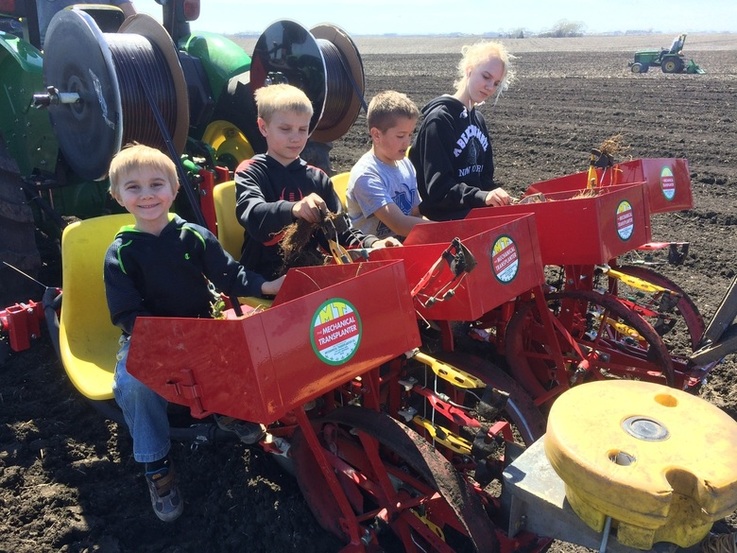We are surrounded by corn, bean and sugar beet fields, so we know the rhythm of the corn & beans crop rotation in the mid-west. On our strawberry farm, we also rotate crops, but it looks nothing like our neighbors’! We plant baby strawberry plants every spring. It takes about an hour to do 1000 plants, if all of us work together. This spring, we planted 33,000!
Two of us sit on the red planting machine, loading the little plants into the wheel, which carries the plant down to the ground and firmly places it into the soil. Can you tell the girls don’t mind missing a few days of school to plant?
A third person walks behind to make sure the plant is placed properly. If the roots are sticking up, or if the crown is covered, the third person fixes it. The black circle hanging up behind the girls is a roll of irrigation tube. As the baby plants go into the ground, the drip irrigation tube is placed into the ground beside them.
The water barrels on the front of the tractor are delivering a gush of water down through the irrigation tubes to the plants. There are nutrients and vitamins mixed with the water to give the plants a good, strong start — kind of like Miracle-Gro for strawberries.
Breaktime is the best part of planting! The kids get pretty much whatever they want in terms of junk food to help motivate them as the days get long. They rocket back to the house in the golf cart to fetch ice cream bars, candy, hot dogs, or whatever else their heart’s desire.
Within a few weeks, the strawberry plants have hopefully established themselves and started sending out blossoms. In order to encourage plant growth, all of these blossoms need to be clipped off. The kids get to miss more school! We need to do every plant once a week for about 3 weeks before the plant finally figures out that it is supposed to send out plant runners instead of blossoms.
The rest of the summer, we try to keep ahead of the weeds… we aim to weed about an hour a day, but we don’t always hit that goal. The kids get tired, and goofy, but they are good sports about it. We play word games and compose songs to make the time pass. We always end with a root beer float or ice cream bar.
In late October, the baby plants go into dormancy, Dan covers them up with a nice blanket of straw to protect them from the coming winter, and the kids do a happy dance knowing that they can finally stop weeding.
The strawberries rest under the snow and straw, waiting, like the rest of us, for spring.
In the spring, Dan uses our EcoWeeder to push the straw off the strawberry plants and into the path. The straw will conserve water, inhibit weeds, and keep our customers and strawberries clean during harvest.
The mature plants will grow up towards the sun, and send out beautiful white blossoms.
The blossoms will develop into strawberries, and with sun and rain, they will ripen.
Finally, the strawberries are ready for harvest!
After strawberry season, we will keep the field weeded until late October, cover them with straw again, and then next year we’ll get a second picking of strawberries off the same rows.
After the second picking, we get rid of the strawberry plants. Why? Why would we do that after all that work? Well, the weeds have usually gotten ahead of us, and the soil needs a break. We have tried to keep fields a third, and even a fourth year, but the amount of berries we get off them does not even cover our weeding and watering costs. So, we take out the plants and and seed the field with cover crops such as hairy vetch, rye, and sorghum Sudan. The cover crop will put much-needed nutrients back into the soil. Cows graze the cover crop, adding their own form of nutrients:)
The land will get two growing seasons in cover crop before we plant strawberries into it again. Thus, each block of land is part of a five year rotation: Baby strawberries for year one, mature strawberries for years two and three, and cover crop for years four and five.
It is the rhythm of our farm, where we’ve decided to grow strawberries as naturally as possible, and in a way that our entire family can participate. It is not your typical corn and soybean rotation!







